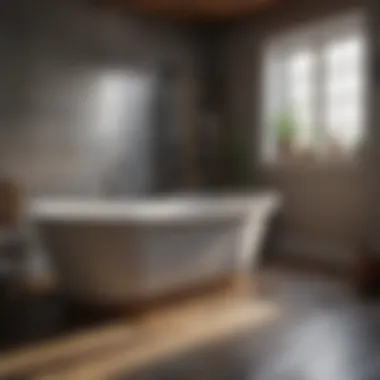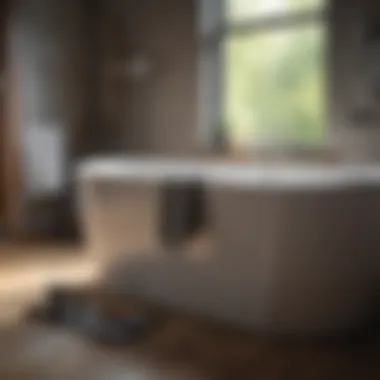Effective Solutions for Clogged Tubs: A Comprehensive Guide


Intro
A clogged tub presents not only a functional hindrance but also an endless source of frustration in any home. When the water fails to drain properly, it interrupts daily routines and can lead to unsanitary conditions. Understanding the root causes and equipping yourself with effective solutions is crucial for maintaining a relaxing bathing environment.
This article will navigate through various approaches to unclogging your tub. It will cover both chemical remedies and natural alternatives, ensuring you have a spectrum of options to choose from. Each method will be explained step-by-step, alongside preventative measures to reduce the likelihood of future clogs. The aim is to equip homeowners with knowledge that empowers them to take charge of their home maintenance.
Let’s explore the effective solutions that can restore functionality and tranquility to your bathroom.
Understanding Clogged Tubs
Clogged tubs present both a nuisance and a significant disruption in everyday life. This initial understanding of the problem is critical for effective resolution. When a bathtub drains slowly or not at all, it affects not only convenience but also hygiene and comfort. Understanding the underlying causes and signs of clogging can aid in prompt removal and prevent future occurrences.
This section will cover insights into the various factors contributing to clogs. Additionally, it will outline how to detect early warning signs before the issue escalates into a major inconvenience. For homeowners, renters, and real estate enthusiasts, recognizing these elements is essential as it outlines practical knowledge that enhances home maintenance and safety.
Causes of Clogs in Bathtubs
Several factors can lead to clogs in bathtubs. Recognizing these causes can help in prevention and prompt action when clogs occur. Common culprits include:
- Hair: One of the most significant contributors to tub clogs is hair. Over time, strands can accumulate in the drain, creating a blockage.
- Soap Scum: Residue from soap can build up in pipes. This accumulation mixes with hair and other debris to form clogs.
- Mineral Buildup: Hard water may lead to mineral deposits in the plumbing system. These deposits can constrict water flow and contribute to a clogged drain.
- Foreign Objects: Items such as toys or small personal items can accidentally fall into the drain, obstructing the flow of water.
- Aging Pipes: Older plumbing can develop leaks or cracks, causing accumulation of debris and leading to clogs.
Understanding these common causes allows homeowners to take preventive measures, ensuring smoother drainage and less frequent clogs in the future.
Identifying Signs of a Clogged Tub
Timely identification of clogs can prevent further complications. Early signs of a clogged tub can be quite subtle but recognizing them can expedite action. Symptoms may include:
- Slow Draining: If water takes unusually long to drain, it may be the first indication of a clog.
- Gurgling Noises: Unusual sounds coming from the drain when water is flowing can signal a clog forming deeper in the system.
- Backflow of Water: Standing water that rises after showering or bathing indicates serious blockage.
- Bad Odors: A lingering smell around the drain may hint at organic matter caught in the pipes, contributing to the clog.
- Visible Debris: Sometimes, hair and soap clumps may be seen in or around the drain.
Recognizing these signs early on is crucial for effective clog management and prevention of complete drainage failure.
Being aware of both causes and signs enables homeowners to respond quickly. This proactive approach to maintenance can save time, money, and the discomfort of dealing with clogged tubs.
Initial Assessment and Safety Precautions
Before diving into the various methods to unclog a tub, it is vital to assess the situation adequately. An initial assessment can save time and effort, leading to a more streamlined approach in addressing clogged tubs. Understanding the severity of the clog has significant implications for choosing the right method and tools. It also aids in identifying whether the issue is a minor obstruction that can be remedied with simple techniques or a more serious problem requiring professional intervention.
Assessing the Severity of the Clog
To determine how serious the clog is, consider the following factors:
- Drainage Speed: Check how quickly water drains. If it is slow but still draining, the clog may not be severe. However, standing water could indicate a significant blockage.
- Previous Clogs: Reflect on any prior clogs. Recurrent issues often signify a more systemic problem that might need professional evaluation.
- Location of Clog: Identify whether the clog is located in the tub's drain or further down the plumbing system. Accessing trouble higher up may be easier than tackling a deeper issue.
- Physical Signs: Look for physical signs, such as unusual odors or gurgling noises during draining, which would indicate additional problems in the plumbing system.
Evaluating these aspects will help in determining the best course of action.


Safety Measures During the Cleaning Process
Safety should always be a primary concern when attempting to unclog a tub. Here are some important aspects to consider:
- Protective Gear: Wear gloves to protect your hands. If using chemical solutions, it’s prudent to have goggles and a mask for protection against fumes.
- Ventilation: Ensure the area is well-ventilated. Open windows or use a fan to prevent fume accumulation when working with chemicals.
- Secure the Work Area: Keep the area free of unnecessary items to avoid accidents. Having clear space will aid in using tools more effectively.
- Awareness of Chemicals: Always read labels on chemical drain cleaners carefully. Understanding the potentially harmful components will help you handle them more safely.
"Safety is not a gadget, but a state of mind."
Implementing these safety measures will not only protect you during the process but also ensure that you can focus on effectively resolving the clog. This assessment stage is crucial, as it lays the groundwork for a successful unclogging experience.
Tools and Materials for Unclogging
Addressing a clogged tub effectively relies heavily on using the right tools and materials. These items not only enhance the chances of successful clog removal but also ensure the safety of the user and the plumbing system. Utilizing proper tools can prevent damage that may occur from using inappropriate or makeshift solution techniques. Moreover, understanding specific tools’ functionalities aids in maximizing efficiency during the unclogging process.
The selection of tools also reflects the extent and type of clog one deals with, whether minor or severe. Therefore, investing time in selecting the appropriate equipment will contribute to effective long-term solutions.
Essential Tools for the Task
Several essential tools can be beneficial for unclogging a bathtub. Among these, the following should be considered:
- Plunger: A standard tool for clearing clogs, often effective against various blockages. Ensure the cup fits properly over the drain.
- Drain Snake or Auger: This tool can reach deeper clogs that a plunger cannot. It is designed to break up or retrieve materials stuck in pipes.
- Bucket: Useful for holding water and debris, allowing for easier cleanup during the process.
- Gloves: Protects hands from chemicals and debris. It’s best practice to wear rubber gloves to maintain hygiene.
- Flashlight: Visibility can be limited, particularly in darker environments. A flashlight helps illuminate the area, ensuring that any blockage can be seen clearly.
Each tool serves a unique purpose and can greatly reduce the hassle when confronted with clogged plumbing.
Common Household Items as Solutions
Sometimes, solutions for unclogging don't need to come from specialized tools. Several common household items can be surprisingly effective in handling minor clogs.
- Baking Soda and Vinegar: This combination creates a natural reaction that can break down gushes of build-up in pipes. Pour baking soda down the drain first, followed by vinegar. Wait for several minutes before flushing with hot water.
- Salt and Hot Water: Salt can help break down grease and soap buildup when combined with hot water. Pour a generous amount of salt down the drain, followed by boiling water.
- Dish Soap: A few squirts of dish soap followed by hot water can work to lubricate and break up gunky build-up, especially useful for oily clogs.
Ending
Whether employing specialized tools or household items, it is crucial to approach clog removal with the right mindset and preparation. Selecting appropriate tools not only enhances effectiveness but also bolsters safety throughout the unclogging process.
Chemical Solutions for Clogged Tubs
Chemical solutions are often considered when facing a clogged tub. Their effectiveness can be significant, making them a popular choice among homeowners. The ability to quickly break down stubborn clogs makes these products appealing. However, understanding the types of chemical drain cleaners available and their implications on both safety and the environment is crucial.
Using chemical drain cleaners must be approached with caution. Their strength can address severe blockages, but improper use may lead to further complications. Knowing when and how to employ these solutions is essential for successful unclogging without causing harm to plumbing systems or the surroundings.
Types of Chemical Drain Cleaners
Chemical drain cleaners come in various formulations, each designed to target different types of clogs effectively:
- Caustic Cleaners: These often contain sodium hydroxide or potassium hydroxide. They work by generating heat and breaking down organic matter. They generally tackle soap scum or hair clogs very well.
- Oxidizing Cleaners: This type typically includes bleach or peroxides. They break down clogs by oxidizing the material obstructing the drain. They can be useful for grease and food clogging but may be less effective for hair.
- Acidic Cleaners: Often containing sulfuric or hydrochloric acid, these cleaners can dissolve almost anything in the drain. However, they’re highly corrosive and should be handled with great care.


Safety and Environmental Considerations
Using chemical solutions poses certain safety risks. Necessary precautions should include:
- Protective Gear: Always don safety glasses and gloves. Chemicals can cause burns if they come in contact with skin or eyes.
- Proper Ventilation: Ensure the area is well-ventilated while using these products. Fumes can be harmful and may induce respiratory problems.
- Avoid Mixing Chemicals: Mixing different chemical drain cleaners can create dangerous reactions, leading to toxic gases or even explosions.
From an environmental standpoint, chemical drain cleaners can be problematic. Many contain harsh ingredients that can affect wastewater processing and contribute to pollution. It's essential to consider:
- Usage Sparingly: Avoid frequent use of harsh chemicals. Alternatives are often safer and equally effective.
- Disposal: Follow local regulations for disposing of leftover cleaners. Improper disposal can harm local water sources.
Natural Remedies for Unclogging
Natural remedies for unclogging bathtubs serve as an essential part of home maintenance. They offer safe, cost-effective solutions without the harsh chemicals found in commercial products. These methods utilize common household items, making them accessible and environmentally friendly. By addressing clogs at their source rather than merely masking the symptoms, these remedies can lead to long-term results. Additionally, they reduce reliance on chemical cleaners that can be harmful to pipes and the environment.
Baking Soda and Vinegar Method
The baking soda and vinegar method is a classic technique for unclogging tubs. This method leverages the natural chemical reaction between these two substances to create carbon dioxide bubbles. These bubbles help to dislodge debris from pipes. Here’s how to use this method properly:
- Gather your materials: You will need half a cup of baking soda, half a cup of vinegar, a kettle of hot water, and a drain cover or cloth.
- Prepare the tub: Start by removing any standing water from the tub. This may require a cup or a small bucket.
- Add baking soda: Pour the baking soda directly into the drain. Make sure it goes down the drain and not on the tub surface.
- Follow with vinegar: Pour the vinegar down the drain immediately after the baking soda. You will notice fizzing and bubbling, which is normal.
- Cover the drain: Seal the drain with the cover or cloth to keep the reactive mixture inside.
- Wait: Allow the mixture to work for about 30 minutes. Meanwhile, boil water until it reaches a rolling boil.
- Flush with hot water: After the waiting period, remove the cover and pour the hot water down the drain. This helps to clear away any loosened debris.
This method is effective for minor clogs. However, for persistent issues, repetition may be necessary.
Salt and Hot Water Approach
The salt and hot water approach provides another natural alternative to address tub clogs. Salt can help break down grease and debris, while hot water aids in flushing it away. This method involves easy steps:
- Prepare the ingredients: Gather about half a cup of salt and a kettle of hot water.
- Add salt to the drain: Pour the salt directly into the clogged drain. The granular texture of salt works to break down stubborn build-up.
- Pour hot water: Follow the salt with hot water, ensuring it flows freely down the drain. The heat allows the salt to dissolve more effectively in the clogged area.
- Let it sit: It is beneficial to let this mixture sit for at least 15 minutes. This will maximize the effectiveness against clogs.
- Flush again if needed: If the clog persists, you can repeat the steps or try a different method.
Natural remedies can be both effective and easy to implement. They promote healthier plumbing and are especially advantageous for those looking to reduce their environmental footprint.
Mechanical Methods for Clearing Clogs
Mechanical methods stand out for their direct approach and effectiveness in addressing bathtub clogs. Unlike chemical solutions, which involve substances that can be harsh or damaging, mechanical techniques utilize tools designed to physically remove blockages. This section delves into the significance of mechanical methods, focusing on their practical benefits and considerations.
Employing a mechanical method ensures that the clog is tackled at its source. These techniques do not rely on corrosive substances that can harm plumbing. Instead, they provide a hands-on approach that any homeowner can implement with minimal investment in tools. Moreover, addressing clogs mechanically often results in immediate results, restoring proper drainage more rapidly than waiting for chemical reactions.
Plunger Techniques
The plunger is perhaps the most well-known tool among homeowners for dealing with clogs. Its design facilitates pressure creation, allowing it to suck up debris blocking the drain.
When using a plunger:
- Select the Right Plunger: Ensure you have a cup plunger specific for drains. A flange plunger, although useful for toilets, may not work effectively in a tub.
- Prepare the Area: Clear the tub of water to expose the drain. If there is standing water, it may be effective to plunge while some water remains—aim for a few inches.
- Apply Appropriate Pressure: Center the plunger over the drain and press down forcefully, creating a seal. Pull up quickly to break that seal, which should dislodge the clog.
- Repeat if Necessary: It may take several attempts to clear stubborn blockages.
- Flush the Drain: Once the clog is gone, run water down to verify drainage is restored.


It's essential to maintain a firm grip on the plunger to prevent splashing and ensure a good seal during the process.
Using a Drain Snake Effectively
A drain snake, or auger, presents another mechanical method for unclogging tubs. It is particularly beneficial when the clog is deeper in the plumbing.
Here’s how to utilize a drain snake:
- Insert the Snake: Begin by feeding the end of the snake into the drain slowly. You want to guide it gently to avoid damaging the pipes.
- Turn the Handle: Twisting the handle of the snake allows it to navigate bends in the plumbing. When you feel resistance, continue twisting to break apart the clog.
- Pull Back: After pushing forward for a moment, pull the snake back slowly. This will remove some of the debris along with it.
- Repeat as Needed: You may need to run the snake through several times until you are confident the blockage is cleared.
- Test the Drain: As with the plunger, once it seems cleared, run water to confirm full drainage is restored.
Mechanical techniques like using a plunger or a drain snake embody practical solutions that empower homeowners to tackle clogs effectively. Understanding when and how to implement these tools can make all the difference in maintaining a functional home drainage system.
Preventative Measures to Avoid Future Clogs
Clogged tubs can lead to frustration and inconvenience. To mitigate these issues, implementing preventative measures is vital. By understanding the factors that contribute to clog formation, one can significantly reduce the chances of encountering this problem in the future. Prevention not only saves time but also costs associated with repairs and professional help. Here are some effective strategies to consider.
Regular Maintenance Tips
Regular maintenance is crucial in ensuring that your tub remains free of clogs. Here are some essential tips:
- Routine Cleaning: Clean the drain cover regularly. Hair and soap scum can accumulate quickly.
- Hot Water Flushes: Once a week, run hot water down the drain for several minutes. This can help dissolve any build-up.
- Bi-Weekly Checks: Every two weeks, inspect the drainage area for any debris or blockages.
- Use Strainers: Installing strainers over the drain can catch hair and other large particles before they enter the pipes.
"Regular maintenance habits significantly increase the longevity of your plumbing system."
Best Practices for Bathing Habits
Bathing habits play an important role in maintaining drain functionality. Here are some practices that can help:
- Rinse Before Bathing: Rinsing off before entering the tub can reduce the amount of soap and hair that goes down the drain.
- Limit Product Use: Reducing the number of products used during bathing can decrease the residue that builds up over time.
- Avoid Excessive Hair Loss: Consider using products that reduce hair fall, especially if long hair is in question.
- Educate Family Members: Teach everyone in the household about proper hygiene practices to minimize bathtub clogging risk.
These methods not only help maintain a clear tub but also contribute to better home hygiene overall. Implementing these preventative measures could save you time, effort, and money in the long run.
When to Seek Professional Help
Addressing a clogged tub can seem like a simple task, but certain situations require the expertise of a professional plumber. Recognizing when to seek assistance is crucial for ensuring that the problem does not escalate or cause further damage. This section explores the signs indicating that it might be time to contact a professional and the advantages of doing so.
Identifying Severe Clogs
Not all clogs are created equal. Some can be resolved with household methods, while others may point to more significant plumbing issues. Severe clogs typically present with specific indicators:
- Repeat Clogging: If a previously cleared clog reoccurs in a short time, this can signify deeper plumbing issues.
- Multiple Drains Affected: If more than one drain in your home is slow or clogged, it suggests a broader problem in your sewer line.
- Foul Odors: Unpleasant smells emanating from the tub drain may indicate a blockage that is decaying or backed up waste.
- Gurgling Sounds: Unusual noises when draining can suggest that air is trapped in the pipes, pointing to a severe clog.
- Sewage Backup: Any return of wastewater is a serious issue that demands immediate professional attention.
If you identify any of these signs, it is advisable not to delay in calling a plumber. Waiting could lead to more costly repairs and greater inconvenience.
Hiring a Plumber: What to Expect
Enlisting in the services of a plumber can feel intimidating, but knowing what to expect eases this process:
- Initial Assessment: Upon arrival, the plumber will assess the problem, looking for the root cause of the clog.
- Diagnostic Tools: They may use video inspection tools, enabling them to see deep inside the pipes without invasive procedures.
- Treatment Plan: After diagnosing the issue, the plumber will present options for resolution, which could range from clearing the clog to recommending repairs for your plumbing system.
- Cost Estimates: Generally, you will receive an estimate for the work required. This step allows for transparency about financial implications before work begins.
- Post-Service Advice: After resolving the problem, the plumber may offer preventative tips tailored to your home to avoid future clogs.
A plumbing professional changes the inconvenience of a clogged tub into a managed solution, helping to ensure your plumbing remains in excellent condition. This proactive approach ultimately saves money and maintains the longevity of your home’s plumbing system.



